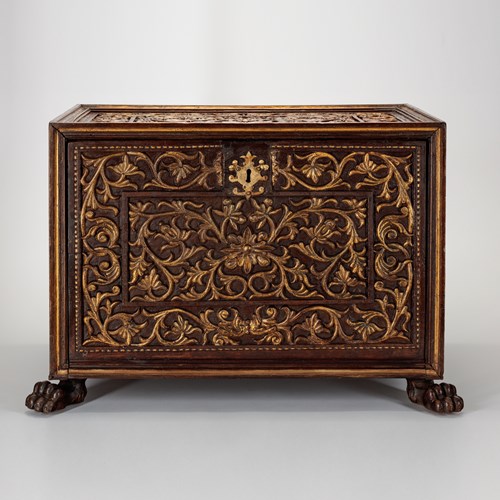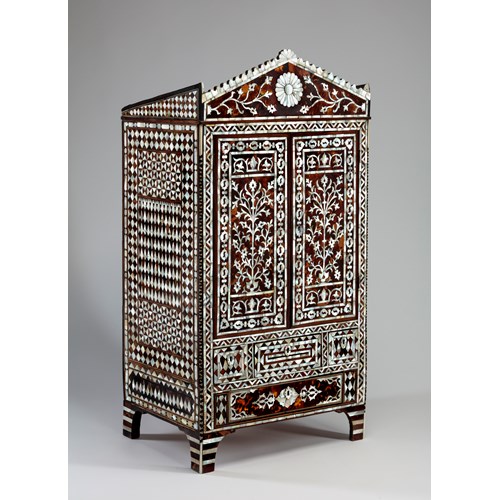Marketplace
EBONY BOX
This ebony playing card box, with space for three decks of cards, is made from wood retrieved from a shipwreck. The S.S. Bengal began its life in 1853 as a passenger liner under P&O. After 1870, it exchanged hands a number of times, becoming a troop ship during the Abyssinian War and the Near East Crisis. Finally, the S.S. Bengal was registered to Gellatly, Hankey, Sewell, and Co., under whose ownership it was wrecked off Bawcan Island, Java, in March 1885, on a passage from Saigon to Sourabaya with a cargo of rice.1 A plaque on the underside of the box, engraved ‘P&O S.S. BENGAL’, gives a date of May 15th 1893, perhaps commemorating the gifting of the box to its recipient.
The focal point of the lid is a roundel containing a green peafowl, a bird related to the peacock. Not only is this bird native to Java, where the S.S. Bengal was wrecked, but it is also a symbol of Myanmar. Several iterations of the flag have featured a similar roundel containing a green peafowl, and this symbol was also adopted as the ensign of British Burma. The six figures on the box are depicted in traditional pre-colonial Burmese dress, consisting of longyi (trousers) and pinni (a long jacket), with their hair in high buns.2 The carving, characterised by swirling floral bursts and hatched textured areas, is typical of Konbaung Dynasty Burma. Examples of this style can be seen in the V&A (accession nos 02035(IS) and 01185A/(IS)). The wood from the wreck off the coast of Indonesia may have made its way to British Burma to be carved by local craftsmen and gifted to the owner of the monogram ‘GM’ found on the bottom of the box.
1‘Ship Fact Sheet: Bengal (1853)’, P&O Heritage, published online in 2008 https://www.poheritage.com/Upload/Mimsy/Media/factsheet/92807BENGAL-1853pdf.pdf
2 Targosz, Tobiasz, Sławik, Zuzanna (trans.) ‘Burmese Culture During the Colonial Period in the Years 1885-1931: The World of Burmese Values in Reaction to the Inclusion of Colonialism’, Politeja 44 (2016), 277-300; 287.
The focal point of the lid is a roundel containing a green peafowl, a bird related to the peacock. Not only is this bird native to Java, where the S.S. Bengal was wrecked, but it is also a symbol of Myanmar. Several iterations of the flag have featured a similar roundel containing a green peafowl, and this symbol was also adopted as the ensign of British Burma. The six figures on the box are depicted in traditional pre-colonial Burmese dress, consisting of longyi (trousers) and pinni (a long jacket), with their hair in high buns.2 The carving, characterised by swirling floral bursts and hatched textured areas, is typical of Konbaung Dynasty Burma. Examples of this style can be seen in the V&A (accession nos 02035(IS) and 01185A/(IS)). The wood from the wreck off the coast of Indonesia may have made its way to British Burma to be carved by local craftsmen and gifted to the owner of the monogram ‘GM’ found on the bottom of the box.
1‘Ship Fact Sheet: Bengal (1853)’, P&O Heritage, published online in 2008 https://www.poheritage.com/Upload/Mimsy/Media/factsheet/92807BENGAL-1853pdf.pdf
2 Targosz, Tobiasz, Sławik, Zuzanna (trans.) ‘Burmese Culture During the Colonial Period in the Years 1885-1931: The World of Burmese Values in Reaction to the Inclusion of Colonialism’, Politeja 44 (2016), 277-300; 287.
Plus d'œuvres d'art de la Galerie









